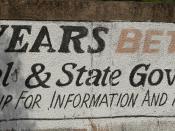Satya Djojosugito Hugh Judd
Research/Presentation Paper MGMT 320 B
Bhopal Tragedy: Should Union Carbide Corporation (UCC) be held most responsible for not Imposing Higher Standards on operations than are required by India's Laws and Standards?
On the night of December 2nd 1984 in Bhopal, India, a gas leak of Methyl Isocyanate, which is a toxic substance when exposed to humans, occurred in a pesticide plant owned by Union Carbide India Limited (UCIL), a subsidiary firm of the parent company headquartered in Connecticut, USA, Union Carbide Corporation (UCC). The impact of this gas leak has created one of the worst industrial disasters to date. Following the incident, there were 8,000 casualties within the first week, 100,000 individuals permanently disabled, and approximately 520,000 people directly harmed1. The question that lingers is: who is held responsible for these catastrophic damages? After extensive research, it is clear that UCC had the majority ownership of UCIL, was actually capable of imposing higher standards to the operations in Bhopal by using its vast amount of wealth, and were plain out ignorant despite recognizing harmful incidents in other subsidiaries, previous gas leakages, and double standards between their pesticide plants in West Virginia and Bhopal.
As a worldwide multinational enterprise (MNE) that has over 500 facilities across 34 countries1, Union Carbide Corporation should have imposed higher standards to the operations of UCIL than are required to by India's own laws and standards.
Problem 1- Great amount of ownership in UCIL
UCC should be held more responsible for the Bhopal tragedy because they had the biggest proportion of ownership in UCIL. In fact, when UCIL was first established in India, UCC held a "60 percent majority" ownership2. Although this amount has been reduced throughout the years building towards the incident to 50.9 percent,


